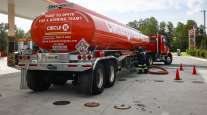Opinion: Focus on Fuel Standards
By Randy Cornell
Vice President of Maintenance and Asset Management
Con-way Truckload
This Opinion piece appears in the April 28 print edition of Transport Topics. Click here to subscribe today.
Trucking industry leaders constantly investigate new methods for improving fuel mileage. As today’s trucking leaders look closely at new policies aimed at developing higher minimum fuel standards for medium-duty and heavy-duty trucks, we also recognize opportunities for bringing consumer costs under control and strengthening the economy while reducing dependence on foreign oil, lowering carbon emissions and minimizing business costs.
Manufacturers, shippers and truckers are all concerned stakeholders eager to bring their ideas, experience and expertise to the industry table. Working collaboratively will produce practical, attainable targets and create an effective structure for increased fuel efficiency and lower emissions.
We must begin by considering what has been done in the past and carefully examine what worked and what didn’t.
Regulatory standards issued in 2004, 2007 and 2010 were mandated and implemented. The new requirements served to reduce carbon emissions — but they also resulted in a marked increase in overall costs for trucking companies and shippers.
Industrywide, carriers have noted that new truck costs have increased more than 35% over the past six years, largely because of the increased costs of emissions-control technology. Maintenance costs for new equipment also have increased significantly.
Through no fault of their own, original equipment manufacturers have found themselves rushed by restrictive timeframes to develop and deploy new emissions technologies. The OEMs were able to meet production deadlines, but there was no time for long-term testing of the system for degradation.
While the emissions systems performed admirably “out of the box,” their reliability deteriorated during the first three to four years of use, an issue that would have been exposed by an extended and thorough testing period. The number of breakdowns industrywide increased dramatically between 2006 and 2013.
However, as efforts to attain cleaner exhaust from engines have continued, the technology continues to change, requiring more parts and maintenance. With the fast-paced technological advances of today’s engines, repair and maintenance facilities are challenged to take technicians off the shop floor for training, while at the same time trying to keep up with ever-increasing numbers of trucks needing repair. Trucks stay down longer, creating an extensive backlog in our nation’s freight network, as well as tightened capacity.
Inevitably, reduced capacity means shippers pay more. With carriers incurring ever-higher costs to invest in and maintain technology to control emissions, purchase newer, more fuel-efficient trucks and pay drivers for downtime, capital expenditures available for reinvestment continue to shrink. These costs are passed on to shippers, with consumers ultimately paying more for goods.
The challenges of improving fuel efficiency while lowering carbon emissions are daunting, but not insurmountable. Realistic timelines for the implementation of new standards would help prevent new technology from being rushed into service before it is fully ready for prime time. The importance of thorough research and development cannot be overstated. Advanced technology and production methods call for repeated critical analysis and evaluation of the systems to determine durability, reliability and service life.
Improved technology and equipment isn’t the only solution, however. Drivers can have a significant effect on fuel efficiency. Ongoing driver training will keep operators abreast of the latest methods and innovations available to increase their average miles per gallon.
Drivers who practice proven techniques like progressive shifting to keep engine rpm t a minimum are able to achieve significant fuel savings. Reducing highway speed by an average of just 3 mph will result in a noticeable improvement in fuel economy.
A collaborative effort to plan and fund improvements of our nation’s highway infrastructure also would alleviate congestion and immediately enhance safety and fuel efficiency. According to American Trucking Associations, about 70% of the nation’s commodities are delivered by truck. Delays caused by the deterioration of the country’s roads, highways and bridges, as well as high traffic volumes, contribute to increased prices for consumers and increased carbon emissions.
Effective collaboration between government, trucking companies, shippers and manufacturers is necessary to address these problems. Sustainability and energy independence can be attained through research, education and a mutual commitment to cooperation toward a common goal.
Joplin, Mo.-based Con-way Truckload is an operating company of Con-way Inc. and is a leading provider of expedited, time-definite full-truckload transportation services across North America.




